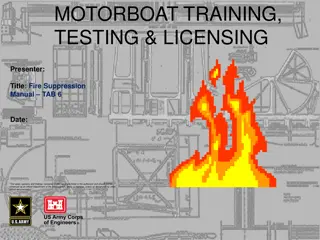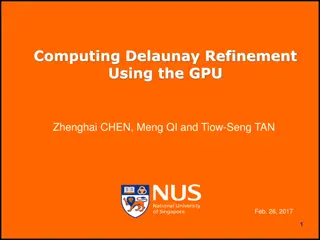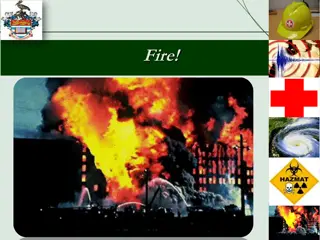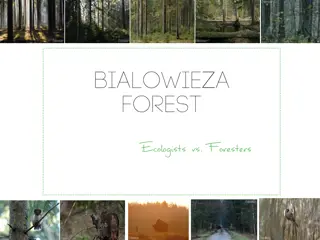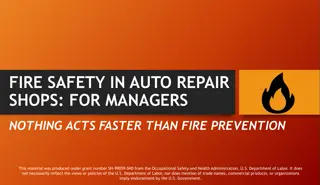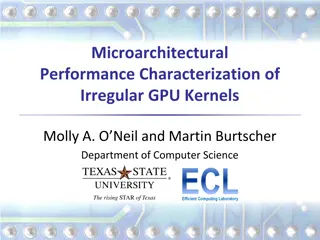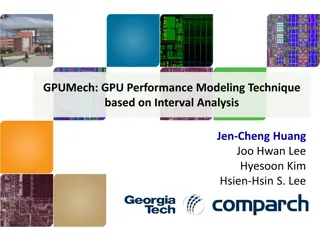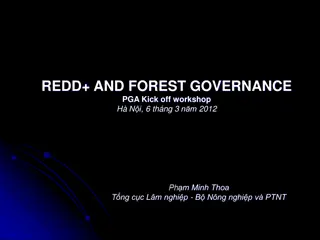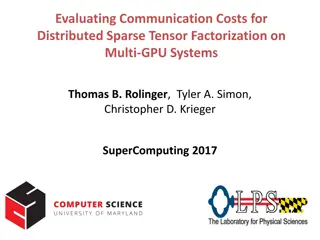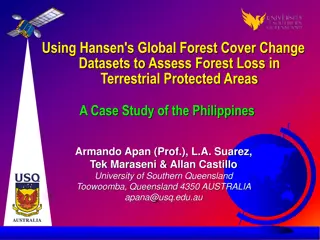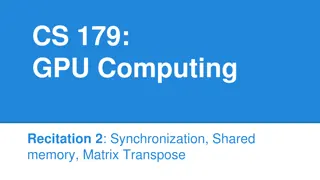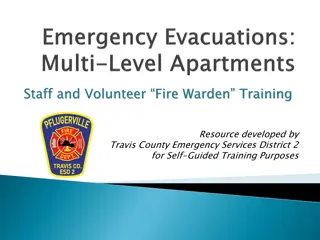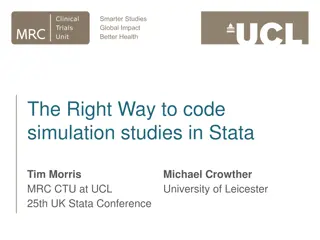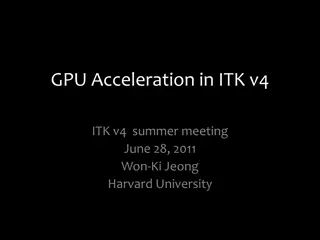vFireLib: Forest Fire Simulation Library on GPU
Dive into Jessica Smith's thesis defense on vFireLib, a forest fire simulation library implemented on the GPU. The research focuses on real-time GPU-based wildfire simulation for effective and safe wildfire suppression efforts, aiming to reduce costs and mitigate loss of habitat, property, and life. The study outlines components such as fuel load, type, wind, and moisture crucial for modeling fire spread and differentiates base fire, crown fire, fire acceleration, and spotting in forest fires.
Download Presentation

Please find below an Image/Link to download the presentation.
The content on the website is provided AS IS for your information and personal use only. It may not be sold, licensed, or shared on other websites without obtaining consent from the author. Download presentation by click this link. If you encounter any issues during the download, it is possible that the publisher has removed the file from their server.
E N D
Presentation Transcript
vFireLib: A Forest Fire Simulation Library Implemented on the GPU A Thesis Defense By Jessica Smith
Dedication To Madeline, Melody, and Lily My future coding army 2
Acknowledgements Thank you to Dr. Harris, Dr. Dascalu, and Dr. Wang for being on my committee Thank you to my labmates for assisting me during the process of this project Special thanks to Chase Carthan and Thomas Rushton for putting up with my debugging This material is based in part upon work supported by: The National Science Foundation under grant number(s) IIA-1329469, and Cubix Corporation through use of their PCIe slot expansion hardware solutions and HostEngine. Any opinions, findings, and conclusions or recommendations expressed in this material are those of the author(s) and do not necessarily reflect the views of the National Science Foundation or Cubix Corporation. 3
Outline Introduction Background and Related Work Real-Time GPU-Based Wildfire Simulation Analysis and Conception Modeling and Implementation Results Conclusions and Future Work 4
Outline Introduction Background and Related Work Real-Time GPU-Based Wildfire Simulation Analysis and Conception Modeling and Implementation Results Conclusions and Future Work 5
Introduction Every year, fighting forest fires costs taxpayers in the United States millions of dollars From 2002 to 2012 the average amount per year spent on fire suppression amounted to $962 million This cost only covers 32% of wildfire protection funds [13] This cost does not include other important cost factors: Loss of habitat Loss of property Loss of life A better ability to model and simulate real-world forest fires would allow for more effective, safe wildfire suppression efforts 6
Introduction In order to simulate wildfires, scientists have developed several methods for modeling fire propagation [4,30,29] Components to calculating fire spread: Fuel load, Fuel type, Wind, Live moisture, Dead moisture, Crown height Four parts of a forest fire [24] Base fire Crown fire Fire Acceleration 7 Spotting
Introduction The Graphics Processing Unit (GPU) is ideally suited to large-scale computations when each element must undergo the same processing The GPU may process millions of inputs simultaneously [31] Conversely, the CPU may process only a few The key difference: CPU threads are much more powerful than GPU threads In a one-to-one comparison, the CPU thread will beat the GPU thread every time 8
Outline Introduction Background and Related Work Real-Time GPU-Based Wildfire Simulation Analysis and Conception Modeling and Implementation Results Conclusions and Future Work 9
Background and Related Work The most widely-used propagation model in wildfire simulators was developed by Richard C. Rothermel [30] Rothermel s spread equations use properties of fuel models to predict the spread in a given direction of the fire [29] Rothermel developed the first eleven fuel models A wildfire simulation is broken up into cells, each having its own set of properties including: Fuel properties 10 Moisture properties
Background and Related Work Three types of fire models [24,26]: Empirical: use statistical descriptions of wildfires to predict where they may go based on empirical tests in controlled environments. Limitation: These have had limited success in their usefulness as the environments are too controlled in a laboratory to simulate real-world forests. Theoretical: Rely solely on physical principles, so they are based on known properties of the forest. Limitation: Input data is hard to come by. Semi-Empirical: A combination of theoretical and empirical data, which incorporates the best of both words mentality. 11 Limitation: a smaller combination of both of the above
Background and Related Work The majority of simulators use Rothermel s equations which are as follows[30]: Where R is the rate of spread. (Ip)o is the no-wind propagating flux, wand s are the additional propagating flux introduced by wind and slope respectively. The product of band is referred to as the effective bulk density. Qigis the heat of preignition. These values are derived from or contained in the fuel model for each cell The desired output of a wildfire simulator is a time of arrival map depicting when a cell ignites and begins contributing to the spread of the fire 12
Background and Related Work The method for propagation of a fire determines the method by which time iterates in a simulation Three methods implemented in this work: Minimal Time (MT) Iterative Minimal Time (IMT) Burn Distances (BD) MT and IMT are based on work done by Sousa, dos Reis, and Pereira [34] Implemented methods on the GPU 13 BD is based on work on by Hoang [15,16, 17]
Background and Related Work: Crowning Crowning is the phenomena of a fire spreading from the forest floor to the crowns of the trees [35, 36] Passive Crowning: The crowning does not impact the spread of the fire Active Crowning: The crowning increases the maximum rate of spread of the fire in that cell This work implemented the same method for crowning as used in vFire [15,16, 17] who based their implementation on FARSITE [11]. 14
Background and Related Work: Spotting Spotting occurs when firebrands from the wildfire are lofted into the air and fall ahead of the advancing flame wall, igniting a new fire Three main components: Generation [18,19,21,32] Transport [11, 19] Figure taken from [2] Ignition [18,28] 15
Background and Related Work: Spotting Spotting occurs when firebrands from the wildfire are lofted into the air and fall ahead of the advancing flame wall, igniting a new fire Three main components: Generation [18,19,21,32] Transport [11, 19] Figure taken from [2] Ignition [18,28] 16
Background and Related Work: Fire Simulators BEHAVE [4] Developed in 1986 Two main functions: Run a point-in-time simulation Test new fuel model data Used by researchers to develop new fuel models and test them outside a laboratory environment Also used as a training tool for firefighters 17
Background and Related Work: Fire Simulators fireLib [6] Developed in 1996 Updated BEHAVE s models and implementations to modern platform using C Runs much faster than BEHAVE, and output is generated over time as a time-of-arrival map. Each (x,y) in the output corresponds to a cell in the fire. 18
Background and Related Work: Fire Simulators FARSITE [11] Continually developed since 2004 FARSITE runs entirely sequentially, which makes it extremely slow It has very comprehensive inclusion of forest properties and models with the ability to incorporate advanced geospatial data 19
Background and Related Work: Fire Simulators vFire [15,16,17] Developed in the High Performance Computing and Visualization lab by Dr. Roger Hoang vFire was the first forest fire simulator to utilize the parallel parameters of the GPU to decrease computation time needed to run a simulation by using OpenGL s GLSL [33] The visualization and data processing of this simulator are tied together 20
Background and Related Work: Fire Simulators FIRETEC [20] The only simulation package that does not use Rothermel s spread equations to determine spread patterns Uses theoretical models of chemical reactions and heat transfers to determine where the fire will propagate Very computationally expensive Mainly used for research purposes 21
Background and Related Work: GPU Computation GPU s were originally designed for accelerating graphics with very specific fixed- function pipelines vFire was developed under the fixed-function pipeline constraint In 2006, NVIDIA released CUDA which was the world s first solution to general- purpose computing on the GPU [23] The architecture of the GPU allows for thousands of low-powered threads to run in parallel 22
Background and Related Work: CUDA CUDA allows programmable kernels to be written that take advantage of the thousands of cores available [23] A kernel is a small bit of code that is run by a thread on the GPU Host: Machine which runs the parent code that calls the CUDA kernels Device: The GPU and its associated resources Data must be transferred between the host and device A thread is allocated in a block, and a block belongs to a grid There are 2-3 grids per GPU 23 Up to 65535 blocks per grid, or in later compute capabilities it increases to 2311
Background and Related Work: CUDA This figure shows the changes in block/thread/grid sizes based on the CUDA Compute Level. Figure from [37] This figure presents a visualization on the differences between grids, blocks, and threads. Figure from [32] 24
Outline Introduction Background and Related Work Real-Time GPU-Based Wildfire Simulation Analysis and Conception Modeling and Implementation Results Conclusions and Future Work 25
Real-Time GPU-Based Wildfire Simulation vFireLib is a wildfire simulation library that takes advantage of the highly-parallel nature of the GPU The propagation, crowning, and spotting are all implemented as CUDA kernels The existing fire simulators (excluding vFire) all run sequentially, which limits their real-time usefulness. The GPU allows each time tick in the simulation to be processed simultaneously across the entire simulation Unless the size of simulation exceeds the possible number of threads 26
Real-Time GPU-Based Wildfire Simulation The focus of this work: Improve runtime to achieve faster-than-real-time simulations on real-world complex data. The models used in this paper are first found in vFire and FARSITE vFire provided the basis code for the data processing portion of this project, but had to be re-implemented without using GLSL This work will be available as a library which will allow users to run a custom fire simulation on one of three propagation methods with crowning and fire acceleration methods available 27 Spotting has been implemented as a prototype for future work in this work
Outline Introduction Background and Related Work Real-Time GPU-Based Wildfire Simulation Analysis and Conception Modeling and Implementation Results Conclusions and Future Work 28
Analysis and Conception Functional requirements were created from the behavioral requirements of the library s functionality as used by an outside source 29
Analysis and Conception Non-Functional Requirements were based on the internal interactions of the library functions 30
Analysis and Conception Use Case Diagram: Depicts the interactions of a user (parent program) with the library s functionality 31
Analysis and Conception: Detailed Use Cases Initialize Simulation Data: Read from terrain, fuel, moisture, canopy height, crown base height and crown bulk density files and interpolate them to match simulation size. Initialize CPU Data: Perform pre-processing on the data which will be fed into simulation. This includes pre-calculated values that will not change during the life of the simulation. Whenever there is a change (i.e. a tree bulldoze), this functionality must be performed. Copy to Device: Transfer data from the host to the device to be used by kernels. 33 Propagate:
Analysis and Conception: Detailed Use Cases Crowning Once the fire has been accelerated, a kernel tests for the crowning phenomena. This includes a check to determine if the fire has moved from passive to active, where the maximum spread rate is increased. Spotting Spotting occurs when the initial event of crowning occurs. The firebrand s fall is calculated at each time step. Copy From Device: On full or partial completion of the simulation, to receive the time of arrival map, the data must be copied from the device back to host. 34 Write to File
Outline Introduction Background and Related Work Real-Time GPU-Based Wildfire Simulation Analysis and Conception Modeling and Implementation Results Conclusions and Future Work 35
Modeling and Implementation Once the preprocessing is complete, one of three simulation methods can be applied: Burn Distances, Minimal Time, or Iterative Minimal Time 36
Modeling and Implementation The three propagation methods were found in vFire[16] or the work done by Sousa, dos Reis, and Pereira [34] All three methods use Rothermel s fire spread equation. After preprocessing, the rate of spread is calculated as follows: Equation 5.1 Rmaxis the maximum spread rate. is the eccentricity of the fire, which is based on wind and slope data. is the orientation and is the direction in which the fire is spreading. Rmax, , and are all based on data found in the input files 37
Modeling and Implementation Preprocessing phase: Read in from input files Use Geospatial Data Abstraction Library (GDAL) to interpolate all files to be correct sizes [12] Wind is incorporated as a 2D vector at each cell and is set by a manual input parameter Secondary Kernel There are some slight data dependencies in this project, so a secondary kernel for copying data or updating time was implemented for each method to compensate 38
Modeling and Implementation: Burn Distances The BD kernel simulates the time it takes to physically burn the distance between two cells at a fixed time step Each cell looks to its neighbors to see if it has burned the complete distance for ignition When a cell ignites, it inherits the properties of the fire which ignited it In the case where that fire spreads at a higher rate, it caps it to the max rate of the current cell 39 This is the only floating-point precision kernel out of the three
Modeling and Implementation: Burn Distances There is an issue with data synchronization that arises when reading to and writing from the same time of arrival map Thread 1 processes a, and writes the results out to a . Thread 2 needs to read the data from the cell at a for calculations for c, and receives data relevant to the next time step. 41
Modeling and Implementation: Burn Distances Solution: two time of arrival maps, one for reading and one for writing. New need: the output file needs to transfer data to input file for next iteration This is accomplished in a secondary kernel Note: atomic functions are still used to ensure that during the writeout phase to the output vector, the lowest time of arrival is achieved. 42
Modeling and Implementation: Burn Distances Another issue arose from the fixed-time-step in this method (a), (b), and (c) are all steps in time. The time step is too large and shows a propagating faster than b, when b should be the correct value at the cell in question Fix: make time step smallest time to propagate across a cell, which can be precomputed 43
Modeling and Implementation: Burn Distances The change in distance each time step is calculated as follows: To compensate for overburn , when a cell is found to be ignited, it calculates the time of arrival as: Where doveris the extra distance that was burnt 44
Modeling and Implementation: Minimal Time The MT kernel steps through time by calculating the next-soonest time of arrival and stepping to that point in time When a cell ignites, it inherits the properties of the fire which ignited it In the case where a neighbor cell is already on fire, it is ignored 45
Modeling and Implementation: Minimal Time The same data synchronization issues occur in this kernel as in the BD kernel The solution here is to use the CUDA atomic function AtomicMin() Atomic functions put a lock on a data location so that only one thread may access it at a time This AtomicMin() function ensures that the soonest time of arrival is written to a memory cell Downside: Atomic functions are slow Secondary Kernel: There is no way with CUDA to enforce block-wise synchronization without the termination of a kernel 47
Modeling and Implementation: Iterative Minimal Time The IMT kernel calculates each cell s toa and stops computing when its value converges This is the only method which does not require atomic functions When a cell ignites, it inherits the properties of the fire which ignited it 48
Modeling and Implementation: Iterative Minimal Time This kernel avoids atomic functions and using an if statement through the use of the mathematical equation as follows: ignTimeMin = ignTimeNew*(ignTimeNew < ignTimeMin) + ignTimeMin*(ignTimeNew >= ignTimeMin); 50







